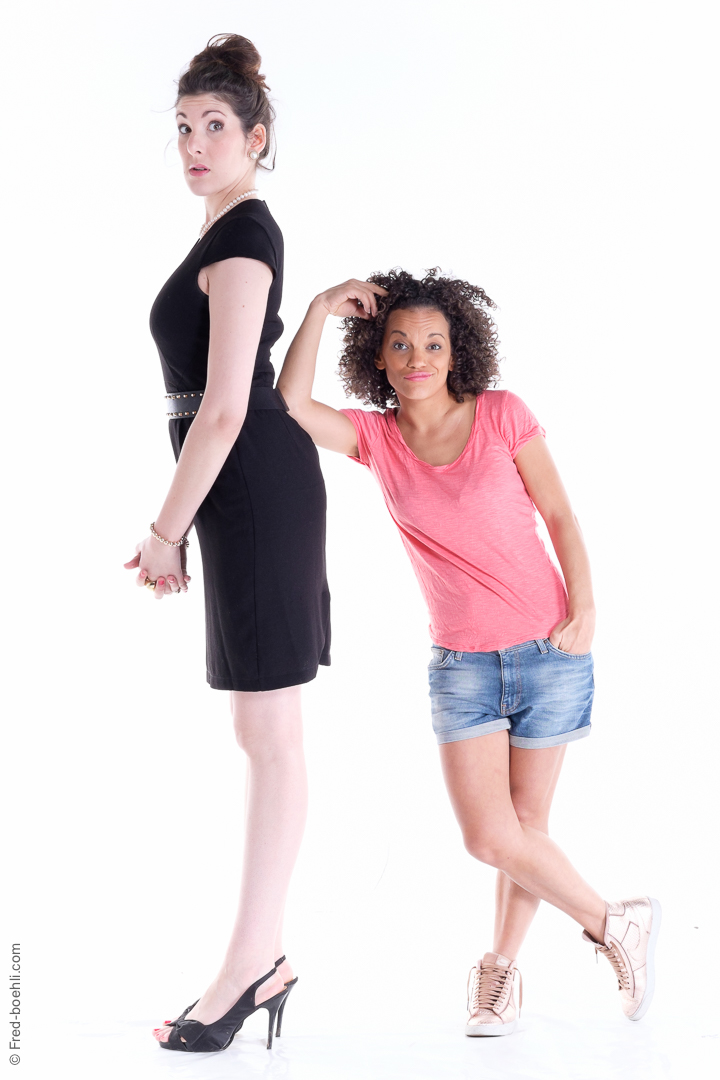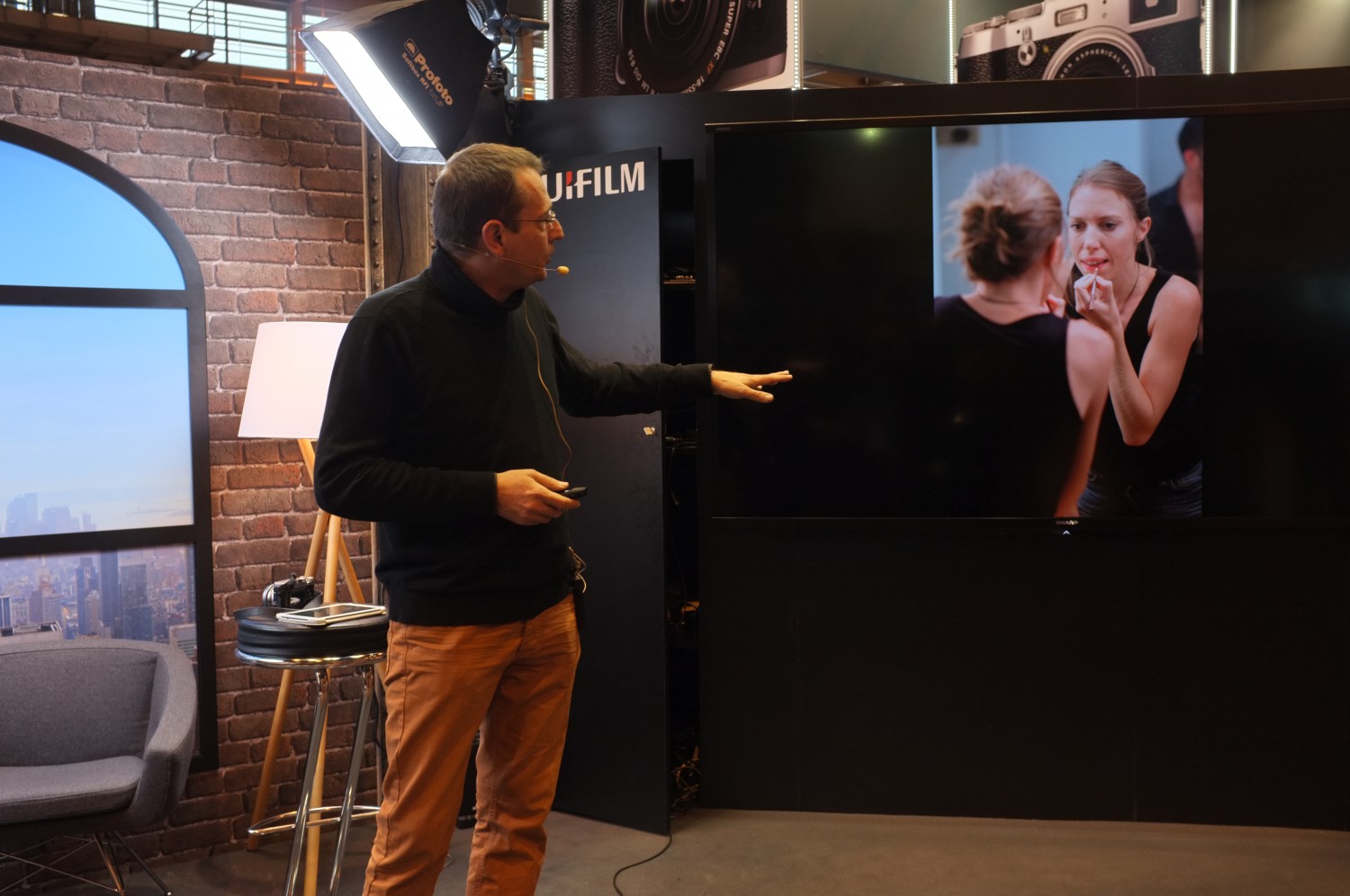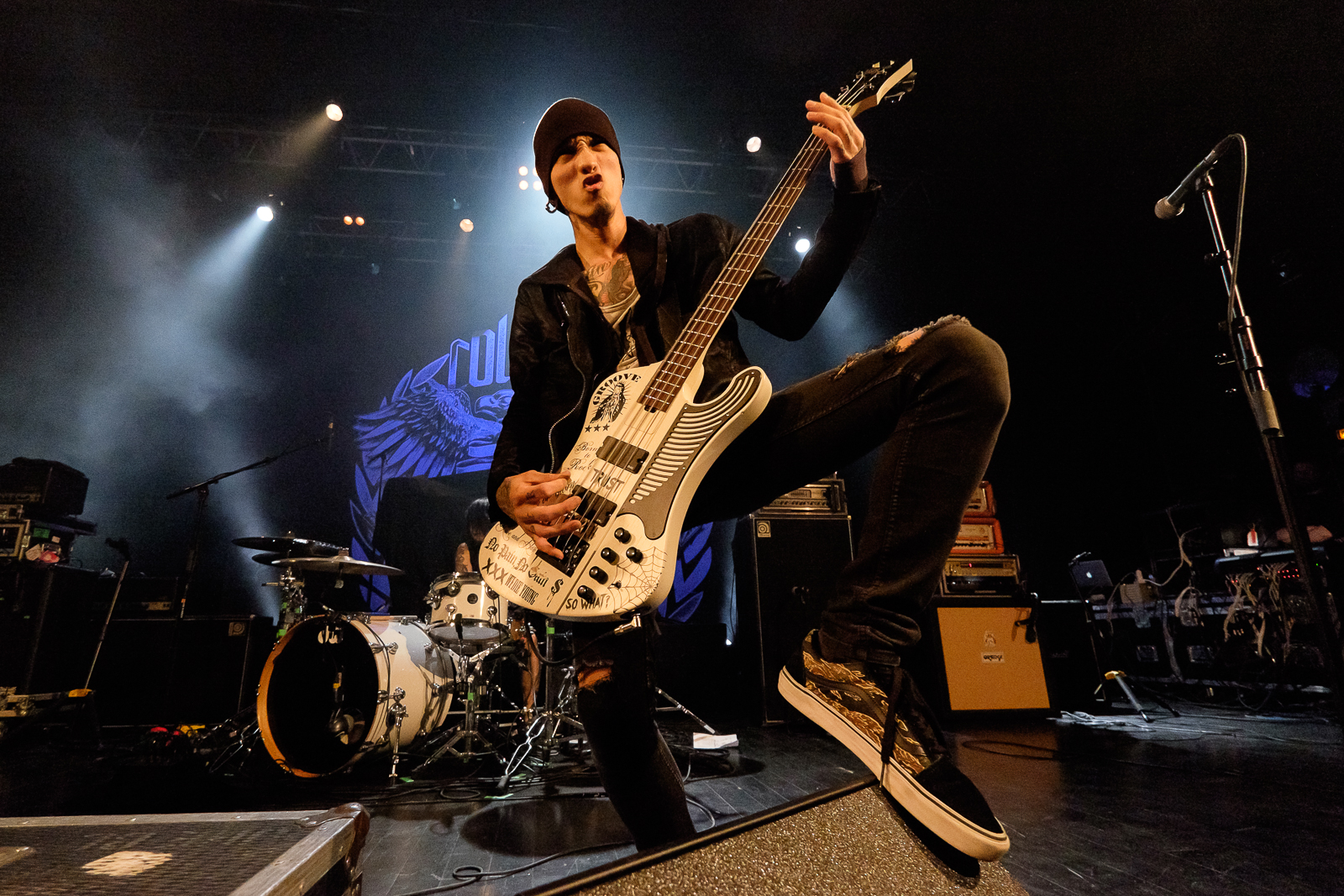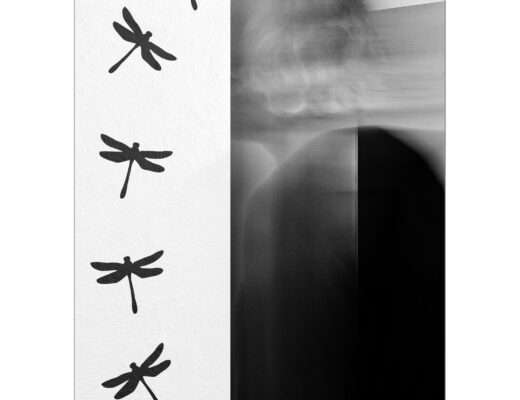I am very happy to present the first interview here on FujiLove. Our today’s guest is Fred Boehli, Fujifilm X-Photographer specialising in photographing artists – musicians and actors. Fred is an official photographer of several French musicians, following them on tours, during concerts and backstage. Enjoy our conversation!
Tomasz Trzebiatowski: For how long have you been using Fujifilm X cameras? What were you using before and why did you decide to make the switch?
Fred Boehli: I have been using Fujifilm X cameras since a year ago as my equipment of choice. I used to work with Pro DSLR cameras and for more than 10 years I was equipped with the Nikon system. I was shooting with D700, D3, D3S and recently with D4, which are truly great cameras. I have also worked using the Pentax system (K5, K3). I was a DSLR addict – not by choice, but because there was nothing else to choose from.
When I started to photograph, I was shooting analog, using Olympus OM 10. In 2008 I made a switch to digital. It was a fantastic way to work, giving me more possibilities and being able to deliver pictures in a very fast way with less technical needs.
During all those times what was disturbing me were the ergonomics: those cameras were heavy (very heavy!) and not so pleasing to keep them in the hand, especially if your photography jobs were going for 8 hours a day, or more…
I have always dreamt about a digital camera that would be easy to cary, not so heavy, with those amazing controlling systems that don’t force you to enter some complicated software setups, or make you think more about the menus instead of concentrating on the essence: easy and pure photography.
When Fujifilm showed the x100 camera – it was in 2011 if i remember well – I was immediately very interested and kept an eye on this system, because it was the kind of camera i was dreaming about: the best of the mechanical old systems with the best of digital … A great promise!
I didn’t get the X100 in in 2011, because for my work I needed a complete system and at this time it wasn’t yet the case with Fujifilm.
The picture quality was incredible, design and ergonomics were fantastic, but with only a compact fixed lens, and no accessories available, it was too limiting for my photographic needs.
The time (and Fujifilm) kept working and at the end of 2013, after observing for a while how the system has been evolving, I finally bought my first x100 to check it out and it was immediatly like if “a dream comes true” feeling…
I was impressed with the ergonomics: that tiny camera with a digital sensor was so great …
I did use this camera for 3 weeks for personal and family purposes – and it was just amazing. Later on I introduced it into my professional work. This incredibly small camera had, in fact, once saved my life.
We were on stage with French humorist Shirley Souagnon (www.shirleysouagnon.com), who I had been working with for many years. We wanted to make some studio jumping pictures, but the lighting system that we rented was not advanced enough and the shooting was just impossible to do with a dslr… We were very disapointed! I had the X100 in my bag and remembered, that it was able to sync the flash up to 1/1000s. X100 did the job! It was amazing to shoot in pro conditions with this little camera! I use the pictures from that shoot until today!
Encouraged with this experience, I began to do more and more pro shooting with the x100. I began to realise that it was replacing my DSLRs on a more and more regular basis. I decided to give more Fuji gear a try: I bought an X-E1 and the XF 18-55mm lens. I still have them today!
It was just incredible: picture quality, ergonomics, versatility were just amazing! Working with the EVF was revolutionary to me: working in real time view with all the information I need in front of my eye was excellent. There were some limitations, but what I was gaining was much more valuable.
My mind and (more importantly) my heart were changing: I was becoming a real Fuji photographer. I contacted Fujifilm and they gave me a chance to test several of their brand new cameras and prime lenses. I was sold. And so was all my DSLR gear 🙂
T.T.: What do you carry in your camera bag nowadays?
F.B.: I love this question! Love it, because i realised one more time that in such a small bag I am able to carry the same amount of equipment, which I used to carry before in big backpack. It just makes me smile. Let me tell you one more thing before telling you exactly what is inside of my Kalahary medium size bag. I need to describe two types of work I do for my clients:
– live pictures, where i need to be as fast as possible, so i need to make use of versatile lenses
– studio or corporate pictures, where picture quality is even more important.
I need to work with primes and with telephotos. And here they are:
– Primes: I work with a Fujinon 56mm f/1,2; a 35mm f/1.4 and a 27mm f/2.8 (because it is so small!). They are all top quality lenses!
– Telephoto lenses: I had worked a lot with the 55-200mm, which is really a great lens, but replaced it recently with the marvellous 50-140mm f/2.8, that better answers my needs when being on stage. With the 50-140mm I gain one more stop of light and it’s important, as I get more speed, or a lower ISO. This lens is just incredible: well made, easy to carry, incredibly fast in terms of focusing, and it delivers incredible image quality. I love it.
I also carry a 10-24mm f/4 for live-shooting. F4 is sometimes less comfortable, but it does the job easily and when you’re just in front stage with a 10 minutes agreement for taking “THE” pictures, this lens allows you to have a large view of all the stage at 10mm and lets you take closer shots at 24 mm as well. Very practical.
Playing with some geometrical deformations at 10 mm is also another fun way of staying creative.
I also have a 18-55mm f/2.8-4: this lens is a great lens, because it is small, stabilised, and delivers a good quality wide open f2.8-4: I think about it like carrying a constant f/4 lens with a little bonus: f/2.8 at 18mm. It is easy to work with and I love this lens, but I will soon equip myself with the 16-55mm f/2.8, because it will be faster to work in very low light, small stage situations.
With Fujinon lenses you don’t have to deal with questions like “Should i buy the 18-55 or the pro grade 16-55?”. They are all fantastic. You only just have to think about your personal needs. No problems with front or back focusing, picture quality wide open, focusing mistakes … They just works as you expect!
MY CAMERAS
I have an X-T1 and I think it’s the best camera I’ve ever had. It’s fabulous in the hand, comfortable to use with its marvellous EVF (makes me definitely forget about an OVF!), easy to operate, quick and accurate… I just love it…
I also have an X100S – it’s my daily camera. I’m thinking about replacing it with a T model, which gained some improvements over the S version.
X100 series cameras follow me everywhere with the 50mm converter. Professionally and privately. Great tools.
With those two cameras I can cover all my needs: very wide angle (10-24) on the X-T1 and 50mm on the X100S give me versatility in front of a concert stage, while the 50-140 on the X-T1 and 23mm on the X100S helps me when being 10 meters above the stage.
I also carry the X-E1 as a backup.
T.T.: You photograph musicians and artists. Are you a musician yourself?
F.B.: I don’t know how to answer it… it has become so instinctive for me… I am not musician myself (I play a little piano and guitar, but I wouldn’t describe myself a musician 🙂
Like everybody else, I love good music!
The fact that I am not musician is in fact a real bonus: I observe artists with more interest, I keep wonder about their “magical secrets”, I don’t hear all faults in their performances. I can focus on what I see and I just enjoy their performances, without worrying or noticing too many technical details.
I don’t think I have to be a musician in order to be a good music-photographer. I always explain it with the following anecdote:- “Hi, there! I am a butcher and I need some pictures taken.”
– “Oh, I am so sorry, I can’t do it for you, because I am not a butcher myself, but let me give you the phone number of a friend of mine: he is a photographer and also a butcher. I personally only take pictures of potatoes, as it’s the only thing I can cook”.
Sharing, pleasure, sensibility and enthusiasm – these are my keywords!
T.T.: What are the most important features of a good music photographer?
F.B.: You will be surprised, but…NONE! Actually you can’t really photograph music. You can record it, at best. But your role as a photographer is to transform it into a two-dimensional form.
There are a couple of things I would like to say about photographing music:
– it is in fact not so complicated to transpose the music into a two-dimensional picture. Musicians are so expressive and engaged when doing their music. You have to capture these emotions. When looking at them on photographs, you can immediately say if it is a hard-rock or a classical musician. Their emotions translate very well to photographic paper. You need to be sensitive and keep your heart, eyes and mind open! You have to stay connected to what is happening on stage. It is a bit like watching a good movie. You don’t have to shoot 1300 pictures an hour. Just concentrate to take the best moments and a little more. It is quality vs. quantity.
– it is usually technically quite complicated: low light or back light, fast action… The circumstances push your camera abilities to its limits. So, you need to know your camera system very well. And of course you have to equip yourself with the system that works well for this kind of work. Just like a musician – he will not play a piano, where a guitar is needed 🙂 I suggest shooting in manual mode. Protect the shadow areas and the face of the artist. You’ll have less trouble in post-processing when working on shadows than highlights. Watch your exposure and your shutter speeds, to freeze the action.
Can you immediatly “see” the sound in the picture below?
As a professional photographer, you have to always stay curious, ready to discover something and share it as a gift or a present… I personally don’t think much about what I’m going to shoot. For example I am not a huge fan of heavy metal but last week I did the shoot and it was amazing! The music was entertaining, musicians were very nice and open-minded, the energy they spread around was fantastic. There is always something new to discover and share!
And that’s important: photography is all about sharing.
In the example below you can see Shirley Souagnon – humorist, that I love so much. I have been her official photographer for the last 4 years, I know her really well. In some circumstances it is an advantage, but to keep my pictures fresh I am always trying to think differently, search for new details, different angles. There is always something new you can discover with your camera.
The most difficult part: you have to anticipate the action and you have to “feel the show”, whether you like it or not.
T.T.: What are your hopes for the upcoming Fujifilm products?
F.B.: I hope Fujifilm continues with their ideology and that’t they don’t change the line of their products. I don’t hope for things like “full frame” etc. I just hope they keep producing amazing lenses, improve their AF options (introduce real tracking). I hope they don’t join any megapixels races: 16 is doing fine, 24 would be the maximum. We don’t need more.

Marie Desroles and Solene Delanoy – French humorists – Promotional shot for their show “l’Amour avec Mention”
T.T.: Your favourite photographer?
F.B.: I love the work of Fujifilm X-Photographers. I think they are the best photographers in the world, don’t you? 🙂 Generally my personal work has been influenced more by painters. I try not to look too much at what the others are doing. It helps me staying connected with myself. If I would have to choose one artist, whose work I really love, it would be a painter here in France. His name is Louis Treserras (www.treserras-berit.com). I love his incredible work.


























